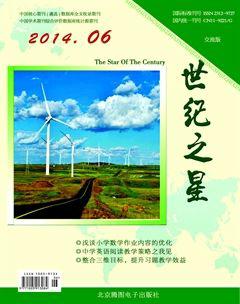The Study of Classroom Questioning of the Rural Middle School English Classroom
2014-09-17张艳梅
张艳梅
【Abstract】 classroom questioning is very important in the English teaching. The research analyzes the present situation of classroom questioning in the rural middle school by the classroom observation and questionnaire. Although the result indicates that the the classroom questioning is effective for the students target language learning, there are still some problems of it.
【Key words】classroom questioning; wait-time of teachers; feedback
1. Introduction
The teacher talk is an important topic researched by the linguistician abroad. As the Nunan(1990)said the teacher talk is not only the tool of teaching, but also an important source of students language input. By the classroom questioning, the teacher can make the students participate into the communication and adjust their language, which help the students better understand the target language (Richards&Lockhart, 1996:185). Classroom questioning is the most common method of classroom teaching and an important part of teacher talk activities. So this paper will study the topic from classroom questioning, wait-time of teachers and feedback.
2. Research Design
The research tries to know the situation of classroom questioning of English classroom in the rural middle school by classroom observation and questionnaire.
2.1 participants
4 teachers and 300 students in Grade 2 are the subjects. They are teachers and students from 4 classes in one of rural middle schools in Nanchong city, Sichuan province. Students age, their level of English and textbook used are the similar. And the teaching experience and teaching methods of the 4 teachers are similar.
2.2 methods and instruments
The 4 teachers are in rural middle school observed for their new lessons. The whole processes are audio-recorded as the data of the research. 4 periods of lessons are recorded as the analysis data, one of which lasts 40 minutes. Finally, the audio-recorded materials are transformed into words. A questionnaire adopted is to collect information of students opinions about research questions.
3. Results Discussion
Table 3.1 Types of teachers questions
From the table, we can see that although teachers are different in their number of display questions and referential questions. And the percentage of display questions are higher than referential ones. Many scholars have mentioned referential questions are more helpful to increase the communicative ability and cultivate students creativity. Therefore, in the English classroom, more referential questions are needed.
Table 3.2 Wait-time of Teachers
Teacher Average wait-time The longest The shortest
In the table 4.2, the average wait-time of teachers is 3 seconds. the result is the similar in the questionnaire. It is clear that the wait-time is not enough to make students to think over. The phenomenon is familiar English classroom in China, especially in rural middle school. The insufficient wait-time will dispirit their students motivation. So the the teacher should extended the wait-time, which helps students participate into the classroom activities.
3.3 Positive Feedbacks of Teachers
Teachers Positive feedbacks
From the table,we can see that 55% of them are the “short and simple praise”, “repetition followed by praise ”occupies 37% and “praise followed by comments” has only 8%. The data of the questionnaire is the similar tendency. That is to say, much of feedback of teachers is rather automatic and mechanical, which cant effectively encourage students to learn.
3.4 Negative Feedbacks of Teachers
Teachers Negative Feedbacks
From the table4.4, we can see that the 4 teachers are willing to use the “guide to self-repair”, which amounts to 62%, while the 21% error corrections are carried by the “turn to other students to answer” and “explicit correction” occupies 17%. We can see that teacher are willing to give positive feedback. But praising in the automatic and mechanical ways, which wont help the students language learning. Therefore,teachers in the later teaching should take notice to their positive feedback, using more “praise followed by comments”. And when errors occur, teachers prefer to guide the students to self-repair by themselves to increase their motivation and confidence.
Reference :
[1]Nunan D. Communicative language teaching: Making it work[J]. ELT, 1987.
[2]胡青球,埃德·尼克松,陈炜. 大学英语教师课堂提问模式调查分析[J].外语界, 2004.
